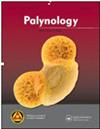Miocene Dinoflagellate Cyst Biostratigraphy of the Península Valdés, Patagonia, Argentina
IF 1.3
4区 地球科学
Q3 PALEONTOLOGY
引用次数: 0
Abstract
ABSTRACT The present work documents the stratigraphic distribution of dinoflagellate cysts from the upper part (60–585 m) of the YPF.Ch. PV. es-1 borehole, Península Valdés, Argentina. The assemblages exhibit a relatively moderate to low diversity. Most samples are characterized by frequent to abundant taxa of the order Gonyaulacales, such as Spiniferites/Achomosphaera spp., Reticulatosphaera actinocoronata, Operculodinium centrocarpum, and Melitasphaeridium choanophorum. Furthermore, a continuous succession of Early Miocene–Late Miocene diagnostic dinoflagellate cyst events was recorded for the first time from the Península Valdés region. Eight diagnostic events of highest occurrences (HOs) of dinoflagellate cyst taxa are identified. These bioevents allowed a subdivision of the sedimentary succession into two well-defined stratigraphic sections: Early to Middle Miocene (Burdigalian–Langhian/probably Serravalian, 430/425–330/325 m) based on the HOs of Emmetrocysta urnaformis, Cannosphaeropsis quattrocchiae, Cousteaudinium auybriae, and Cleistosphaeridium ancyreum, and Late Miocene (Tortonian–Messinian, between 175–170 and 80/85 m) based on the HOs of Labyrinthodinium truncatum subsp. truncatum, Operculodinium piaseckii, and Reticulatosphaera actinocoronata. The ranges of these taxa are compared with well-documented information on Neogene dinoflagellate cysts recorded from different sites across the North and South Atlantic Ocean and adjacent seas. In general, the dinoflagellate cyst assemblages, as well as the selected diagnostic taxa, exhibit a clear similarity to those of the Northern Hemisphere. The only exception is Hystrichokolpoma rigaudiae, which is asynchronous, possibly indicating local paleoenvironmental conditions.阿根廷巴塔哥尼亚Península valdsamus中新世鞭毛藻囊生物地层
摘要本工作记录了YPF.Ch.PV上部(60–585m)甲藻囊肿的地层分布。es-1钻孔,Península Valdés,阿根廷。组合呈现出相对中等到较低的多样性。大多数样品的特征是Gonyaulacales目的频繁到丰富的分类群,如Spiniferites/Achomophaera spp.、Reticulatophaera actinocorata、Operculodinium centrocarpum和Melitasphaerium choanophorum。此外,Península Valdés地区首次记录到中新世早期-中新世晚期诊断性甲藻囊肿事件的连续序列。确定了甲藻囊肿分类群最高发生率(HOs)的8个诊断事件。这些生物事件将沉积序列细分为两个明确的地层剖面:早中新世至中新世(Burdigalian–Langhian/可能是Serravalian,430/425–330/325 m),基于埃默托cysta urnaformis、Cannosphaeropsis quattrocchie、Cousteaudinium auybriae和Cleistophaerium ancyreum的HOs,和中新世晚期(Tortonian-Messinian,175–170和80/85 m之间),基于元宝草Labyrinthodium subsp。truncatum、Operculodinium piaseckii和放线冠网球藻。将这些分类群的范围与北大西洋、南大西洋和邻近海域不同地点记录的新第三纪甲藻囊肿的详细信息进行了比较。总的来说,甲藻囊肿组合以及选定的诊断分类群与北半球的甲藻囊肿明显相似。唯一的例外是Hystrichokolpoma rigaudiae,它是异步的,可能表明了当地的古环境条件。
本文章由计算机程序翻译,如有差异,请以英文原文为准。
求助全文
约1分钟内获得全文
求助全文
来源期刊

Palynology
地学-古生物学
CiteScore
3.40
自引率
26.70%
发文量
48
审稿时长
>12 weeks
期刊介绍:
Palynology is an international journal, and covers all aspects of the science. We accept papers on both pre-Quaternary and Quaternary palynology and palaeobotany. Contributions on novel uses of palynology, review articles, book reviews, taxonomic studies and papers on methodology are all actively encouraged.
 求助内容:
求助内容: 应助结果提醒方式:
应助结果提醒方式:


